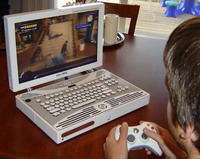"One Laptop Per Child" project is in full force
The faces of the 160 pupils at a public elementary school in this rural South American hamlet beamed: Each sat gawking at a brightly blinking laptop computer given them days earlier.

"This is like an early visit from Santa Claus," beamed 11-year old Eduardo de los Santos, clutching his computer with its shiny white case and bright green trim.
The machines are the first in South America from the much-publicized "One Laptop Per Child" project, which hopes to put low-cost portable PCs in the hands of children in developing countries. Still in a pilot phase, the group has also placed machines at one school in Nigeria and another in Thailand.
At the only public elementary school in this community of 1,300 people, children who never used computers are now being exposed to the digital age. Earlier this week, they eagerly pecked at the machines' keyboards in their white smocks.
"Thanks to this, I'm going to be able to study tons of science," said 8-year-old Joel Nicoletti, who says he wants to be a scientist when he grows up.
The ambitious nonprofit project was launched in 2005 by Nicholas Negroponte, then-director of the media lab at the Massachusetts Institute of Technology.
"There are 1 billion school-age children in the developing world and most don't have an opportunity to learn," said Walter Bender, president of software for the One Laptop project. "We're trying to go where there's an education gap, as technology happens to be a vehicle to bridge that gap."
The laptops currently cost about US$175 (130 EUR), though the project believes the price will drop to US$100 (75 EUR) price once the machines are mass-manufactured. Bender said he even hopes the price might be driven down "someday" to US$50 (37 EUR) each.
And while the first computers to Uruguay were donated, the rest are to be bought by the government, which has budgeted US$15 million (11 million EUR) for the program. A final agreement, however, is still pending.
The portable computers have already transformed the classroom in Villa Cardal.
"The power of these machines is impressive," said the school's principal, Marcelo Galain, noting their promised 12-hour battery life.
He said students got their computers a day ahead of a national holiday, but went on their day off to school to start using them.
There were a few technical glitches getting the computers up and running: Though none of the teachers had much experience with computing, they quickly realized that children with a tilde in their names were having trouble logging on. The bug was quickly fixed.
Some children began warming to the computers by playing "Tetris," a popular falling-blocks puzzle video game. Later they will explore the Linux operating system.
Maria Fojo, mother of 10-year-old twins Lucas and Franco, said her family couldn't afford a computer. Now they have two.
"Lucas took his computer to his grandmother's house and then went to see his godmother with it," she said, adding Franco got hooked on playing with a small video camera installed with the unit.
The computers are designed for children, boast extremely low electricity consumption, a pulley for hand-generated power, 1 gigabyte of flash memory, built-in wireless networking and a screen with indoor and outdoor reading modes.
"The laptops all talk to each other automatically, have voice chat, file sharing and all that can be done between laptops without Internet," Bender said of the design. "If any laptop has access to the Internet all can share it."
Bender said the machines come loaded with children's books in local languages, along with encyclopedias and more.
Uruguay, a small South American country, is one of about a dozen developing nations that signaled interest in participating. The first laptops, along with a wireless Internet connection, were the gift of the One Laptop Per Child project, a nonprofit foundation that has received funding from several companies, including Red Hat Inc., Google Inc. and News Corp.
On May 10, Uruguayan President Tabare Vazquez handed over the "XO" laptops to the school serving Villa Cardal, a community set amid dairy cattle pastures and farmlands about 55 miles (90 kilometers) north of the capital of Montevideo.
Uruguay has fully embraced the laptop project amid high hopes to have laptop computers in the hands of all elementary school students before 2009.
The Villa Cardal students' enthusiasm is something program supporters hope to see repeated in schools worldwide: Other countries that have expressed interest include Argentina, Brazil, Cambodia, Costa Rica, the Dominican Republic, Egypt, Ethiopia, Libya, Nigeria, Pakistan, Russia, Rwanda and Thailand.
Galain said he now sees some students engaged in learning who weren't before.
"Some children who didn't like to even write are now getting used to working with a word processing program," he said.
Still he warned his pupils the newfangled computers wouldn't mean escape from the basics of reading, writing and arithmetic: "Nobody believes the children will stop using pencils and notebooks."
Subscribe to Pravda.Ru Telegram channel, Facebook, RSS!


